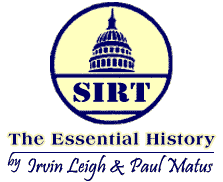
Page 2

Paul had a fondness for riding the SIRT and the Staten Island buses in those days before the Verrazano - Narrows Bridge gave New York City's rural island its first "dry" travel link to the rest of the city, and the idea for the SIRT book was born.
The brothers thought the book would be a piece of cake -- a small but interesting electric railway owned by a major railroad, and a short ferry trip from their home base. They soon found out that the railroad had little documentation of its own history, the parent B&O's archive coughed up only a badly flawed two page mini-history and what material there was would require a lot of leg work, analysis, and cross-checking. By the time the dust settled, a year later, reams of material had been investigated and studied, sources many miles apart had been visited, and most of the railway, included its abandoned branches, had been walked, studied, and photographed.
The good news was that the Matus' had a lot of willing help. The B&O encouraged the SIRT to help them in terms of access to the system and its personnel, and many friends provided information, support, and fine photos to add to the mix. The book became the standard history of the line and, indeed, its quasi-official history. The railroad itself sold the book at its St. George ticket booth, under the banner "Read the Rapid," a pun on the railroad's motto, "Ride the Rapid."
Since the SIRT book went out of print 35 years ago, there has not been much accurate material publicly available on the history of the road, in print or on the 'net, and so the original authors have been accumulating material for an expanded and updated edition. This kind of effort always seems to take longer than one hopes so, in the meantime, we are pleased to present in The Third Rail the essential history of the road excerpted from the 1965 book, with a variety of photos and other materials, some from the book, some never before published.
We are not forgetting all the generous and talented individuals who helped make the original work so popular, and the original acknowledgment and other information about its publication follow the history.
The following material is excerpted from Staten Island Rapid Transit, 1860-1965, ©1965 by Silver Leaf Rapid Transit with editing and additional material ©2001 by Paul Matus.
Prehistory
![]() INSTON CHURCHILL, in
INSTON CHURCHILL, in
A History of the English-Speaking Peoples, wrote of the Stone Age man who might have glanced across the valley that is now the English Channel, and said to his grandson, "The sea comes further up the creek than it did when I was a boy" -- the portent of all that was to make the English civilization so distinct from the others of the Old World.
The SIRT Book
But let's backtrack a little, to 1964.
In that year, brothers Irvin Leigh and Paul Matus, partners in the Silver Leaf Rapid Transit Models company, were thinking about the increasing popularity of the booklets and articles they were writing as an adjunct to their hobby goods import business. In addition to pieces about rapid transit modeling for their own customers and for publications such as Railroad Model Craftsman and Traction and Models, they wrote about transit history. They wanted their next writing effort to be a major historical piece, and had two favorite titles in mind—a history of the BMT Brighton Beach Line and one on the famous 1918 Malbone Street wreck.
Though they had done advanced research and some writing on each of these subjects, they agreed that their preferred topics each had a defect -- they were about the BMT. Silver Leaf and the brothers' writing were already heavily identified with the BMT so they decided that it would be a good idea to branch out to something a little different for their next work.
Updated
©1965 Silver Leaf Rapid Transit. ©2001 Paul Matus. ©2001 The Composing Stack Inc.